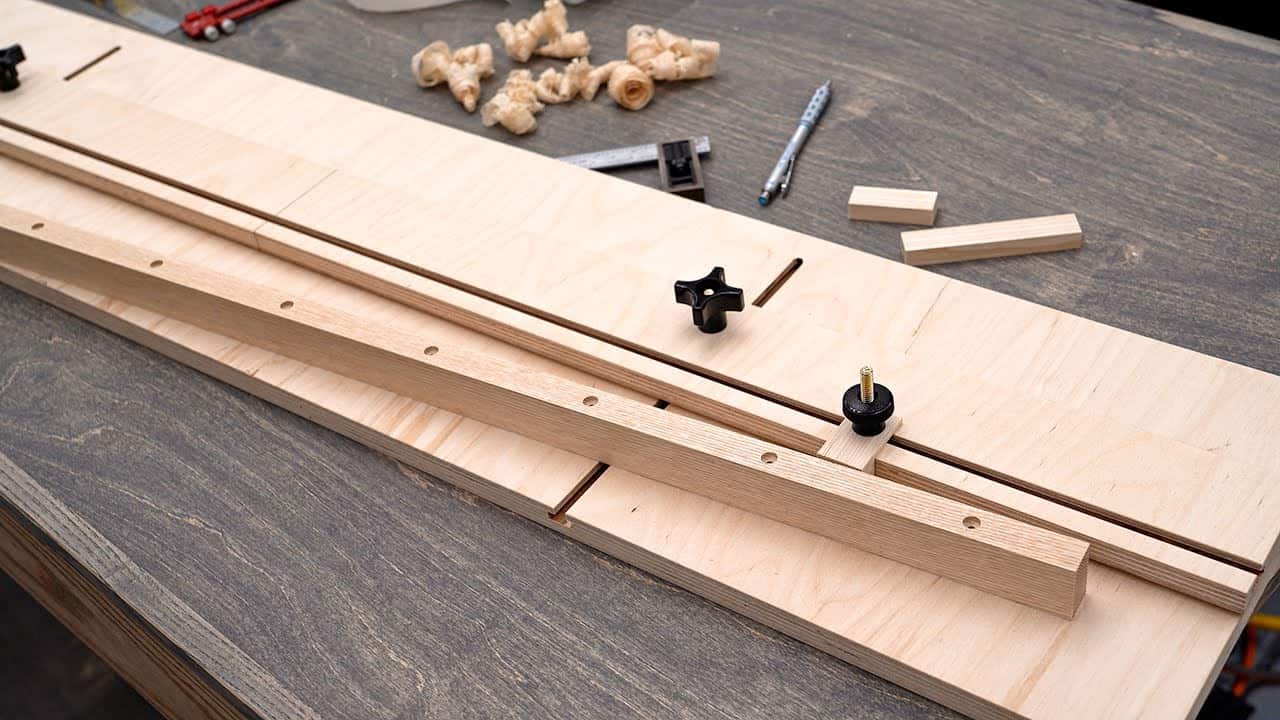Jodee from Inspire Woodcraft shared the woodworking tip featured in this video.
The video demonstrates an adjustable drill-press jig that makes it easy to drill equally spaced holes with high precision even when the workpiece is longer than the drill press table. The jig uses a sliding fence, T-slots, and removable stop blocks so a workpiece can be advanced in exact increments using simple spacers.
Watch the full video and subscribe to Inspire Woodcraft:
Design and Jig Concept
The jig is essentially a wide base with a narrower fence that slides fore and aft, allowing the operator to position the centerline of the drill bit precisely relative to the workpiece.
Adjustable stop blocks at each end lock the workpiece in place so it can be advanced in repeatable steps.
The layout includes T-slots in the fence to accept T-bolts and knobs, which makes it easy to lock the fence at different positions for varying material widths. The overall concept is focused on repeatability and speed rather than complicated indexing mechanisms.
Fabrication Highlights
Construction centers on a routed T‑slot in both the base and the fence so the fence can be adjusted and locked securely, and locating holes are used to align parts during assembly.
Careful setup on the router and clean joinery keep the fence square and the sliding action smooth for consistent results.
Stop blocks are made from a stable hardwood and shaped so they clamp cleanly to the fence, while temporary alignment with double-sided tape or a single locating hole keeps things true during the initial setup. These choices prioritize rigidity and repeatability over fancy hardware.
Using Spacers for Equal Spacing
Instead of a complicated indexing head, the jig relies on a set of spacers cut to the required interval to step the workpiece past the bit. One spacer is half the desired pitch and the others match the full spacing, which allows drilling a run of holes by alternating the smaller spacer followed by full-length spacers.
This spacer method is simple to understand and easy to adapt to different spacings and hole counts, and it works well with the stop blocks to ensure each hole lines up on the same centerline every time.
The technique trades off a few extra pieces of scrap for fast, accurate layout without special tooling.
Setting Up at the Drill Press
Setup involves clamping the jig to the drill press table, aligning the bit to the fence centerline, and locking the table and fence in place so nothing shifts during the run.
The bit depth is set appropriately for the hole being drilled and any necessary countersink or stepped hole is handled by changing bits and rechecking alignment.
When dealing with long or thin stock, the adjustable fence and end stop arrangement prevent the workpiece from walking and keep each hole at the intended location. Taking time to fine-tune the fence position and stop block placement pays dividends in final accuracy.
Accuracy Tips and Lessons
The video emphasizes taking one’s time when cutting the spacers and setting the stops because small errors will accumulate across a run of holes. Double-checking spacer lengths and test-fitting on scrap before committing to the final piece helps avoid a frustrating offset at the end.
Even with a solid jig, visual checks and cautious adjustments are valuable; a quick practice run will highlight any misalignment or slightly long spacers before they affect the finished workpiece. This approach keeps the setup robust and repeatable for multiple parts.
Adaptations and Uses
The jig concept scales well to a variety of drilling tasks, from hardware layout in cabinet backs to positioning shelf-pin holes and repetitive assembly operations. Builders can adapt the fence width, stop-block design, or spacer sizes to accommodate different materials and hole patterns.
Because it’s based on a simple sliding fence and stepped spacers, the method is approachable for shop makers who want precise, consistent spacing without investing in specialized indexing fixtures.
It’s particularly useful when working with pieces longer than the press table or when batch-drilling multiple identical parts.
Why This Tip Matters
This jig offers a low-cost, practical way to get perfectly spaced holes using tools most shops already have, and it emphasizes thoughtful setup and simple mechanical aids over complexity.
The spacer-and-stop approach makes accurate, repeated hole spacing achievable without elaborate jigs or time-consuming layout for every hole.
For anyone who routinely needs evenly spaced holes or works with parts longer than their drill press table, the method shown provides a reproducible workflow that saves time and reduces errors. Jodee’s focus on simple, reliable shop techniques makes the idea easy to adopt and adapt.
Support Jodee by visiting his online store here: https://inspirewoodcraft.com/collections/all.
